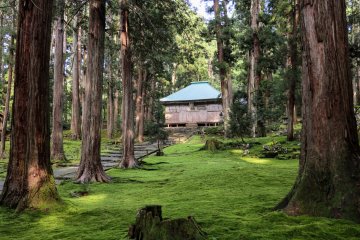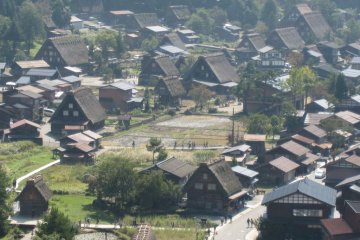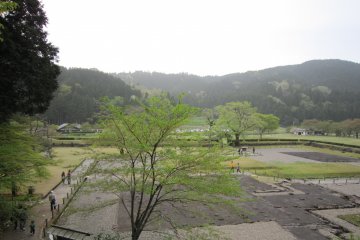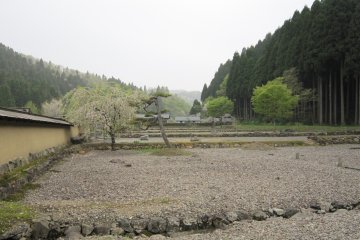When I had moved to and been living in Fukui only for a short while, I went to see Ichijodani Asakura Family Historic Ruins during the Golden Week holiday in May. Usually, if you came to Fukui as a tourist, you'd stay at a hotel in Awara Hotsprings, and probably visit some famous places like Eiheiji, Tojinbo and Fukui Dinosaur Museum. But since I was not a tourist, but a resident of Fukui, I asked around whether there were more interesting places to visit other than the well-known tourist spots. The answer was always, 'Go see the Asakura Ruins'.
The 'Asakura family' didn't ring a bell at first, but when I heard the name paired together with the 'Azai family', like 'Azai & Asakura', I understood right away. Yes, THE Asakura family, which was attacked and defeated completely by Oda Nobunaga!! Nobunaga's sister, Oichi, was married to Azai Nagamasa, whose family had been allied to the Asakura family for generations . When the Asakura family became hostile to Nobunaga, Oichi's husband Azai Nagamasa took sides with the long-time ally, the Asakura family. Together, they were defeated and perished by the enraged Nobunaga's powerful military force. And this place is where the last lord of the Asakura clan, Asakura Yoshikage (1533-1573) of Echizen (now Fukui prefecture) resided, and was burnt to the ground by Nobunaga's army.
Although it's not well-known, there are many historical spots in Fukui where famous historical figures left their footprints. For instance, Oichi, whose husband Azai Nagamasa was brutally killed by her own brother Nobunaga, later remarried one of her brother's loyal subjects, Shibata Katsuie. Katsuie ruled over Echizen after the Asakura family perished from the earth. Yet when Nobunaga was assassinated, he fought with one of his collegues (Nobunaga's loyal subjects) Toyotomi Hideyoshi. His castle, Kitanosho Castle, was surrounded by Hideyoshi's army, and he and Oichi killed themselves inside the castle tower before they were found and killed. The Kitanosho Castle Remains and Shibata Shrine that enshrines Katsuie, are located near JR Fukui Station.
In addition, Nitta Yoshisada's place of death was in Fukui city. Although he destroyed the Kamakura Shogunate with Ashikaga Takauji, and later opposed and fought against Takauji, and was killed by Takauji's army in Fukui. Matsudaira Shungaku, one of the Four Wise Lords at the end of Tokugawa Shogunate, resided in Fukui Castle. In this sense, Fukui could be called a treasure box of historical sights!
Let's get back to the Asakura Ruins. This place was a castle town of the Asakura family until Nobunaga's army burnt it down in 1573. Since then, it had been buried underground, unnoticed, for more than 400 years! It was finally rediscovered and unveiled in 1968, and its excavation is still under progress.
When you reach the site, all you can see is idyllic green fields and mountains, and you'll feel as though you are in a scene right out of the movie 'The Last Samurai'. The whole site is 278 hectares, about 1.8 km square including Ichijodani Valley. So most of the vast scenery you see here are the ruins. Only a small part of Samurai residences in the castle town have been restored so far; other parts of the ruins still remain the same as when they were discovered, though they are well tended. So you see a lot of holes and foundation stones of the castle and residences along with gardens when you get there.
This place has received threefold national property designations. First, the whole site has been designated as Special Historic Sights. Second, four gardens (Suwa Yakata-ato Garden, Asakura Yakata-ato Garden, Yudono-ato Garden, and Nanyoji-ato Garden) were designated as Special Places of Scenic Beauty, Third, 2343 excavated articles from the ruins were designated as Important Cultural Properties. It is quite a surprise that this is one of only five places that have received this honor in Japan. The four other places are world-renowned places such as Kinkakuji Temple, Ginkakuji Temple and Daigoji Sanpoin in Kyoto, and Itsukushima Shirine in Hiroshima! Everybody knows these places but do you know the Asakura Ruins? I doubt it!!
One of the reasons I was surprised was...there was almost nobody there! and I visited in the middle of Golden Week! If you visited those other four places during Golden Week you can well imagine what kind of situation you'd be in. You'd go there to see the historic sights; instead you'd find yourself burried in the crowd and what you could see would be only thousands of heads. But here, you can enjoy the whole 278 hectares to your heart's content! You can breathe in as much oxygen-filled fresh air as you want. For more photos of the place please refer to the photo essay on JapanTravel.
One more thing to add is that near the upperstream of the Ichijodani River which runs in front of the ruins, there is Ichijo-daki (Ichijo Falls), where it is said that the famous swordsman Sasaki Kojiro, who fought with Miyamoto Musashi, came up with the idea of his 'Tsubame Gaeshi (Swallow Counter)' sword technique. This waterfall is the locale of NHK's period drama 'Musashi'. If you are interested in these swordsmen, just drop by the place before you leave the ruins.
To go to the Ichijodani Asakura Family Historic Ruins, you can take the JR Etsubi Kita Line from JR Fukui Station, it only takes 15 minutes. Get off the train at Ichijodani Station, and you'll be there after a 10 minute walk. You can also take a Keifuku Bus at the #9 bus stop at JR Fukui Station, or take the Togo Line bus bound for 'Jokyoji/Shikamata'. It takes about 25 minutes (650 yen) and get off at Buke-Yashiki Mae (in front of the Samurai houses). Or you can also get off at 'Ichijodani Asakura Family Sight Museum' station, from where you can reach the ruins in 30 minutes on foot. Rental bicycles are available at the museum.










